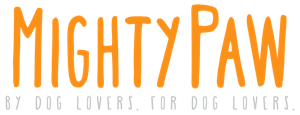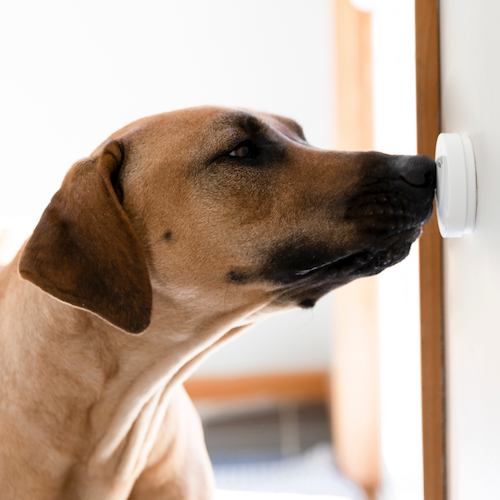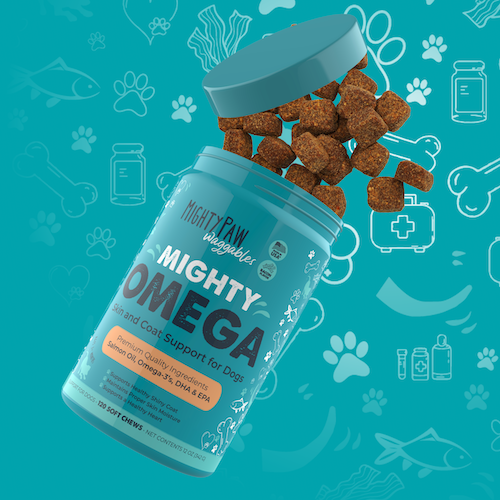Hey Mighty Paw Fam, it's Barbara again and today we're going to tackle Dog Training Resolutions for 2021!
Of course it's easy to set resolutions, so we'll focus more on how to follow through with achievable training goals for and with our pups.
My personal training goals for my pup Wally in 2021 are threefold:
- Get him used to his flight box by the end of March
- Perfect his recall
- Decrease his reactivity on walks
More on that later!
Now without further ado, let's talk Dog Training Resolutions for 2021 and how to go about them.

Dog Training Resolutions for 2021
I recommend to look at the big picture first:
Take a step back and look ahead at the entire year of 2021. Write down dog training commands, activities and behaviors you want to achieve that year.
Also jot down changes in your personal life if you anticipate any. For example, a move to a different city or the arrival of a baby.
Next, break them up into smaller training goals for each quarter.
Set Small Goals For Each Quarter
I believe that it's important to set small training goals for our pups. That's because the smaller the goal, the easier it is to achieve it. It will also make you more motivated to start working towards the next training goal.
The puppy example
For example, if you brought home a new puppy over the Holidays, he's going to need to learn A LOT! Polite behavior around food and people in general, how not to pull on the leash, where to potty, coming when called, how to "leave it", riding in the car, no jumping on people, basic obedience commands, trick training, maybe doggie sports, etc.
That list can seem daunting at best and unachievable at worst!
So in order to make training progress, pick out a few non-negotiables and start with those.
Puppy's first quarter
Looking at training goals for an 8 week old puppy in the first quarter, I would put an emphasis on potty training, listening to their name, going for car rides, teaching a "sit" and the "leave it" command. Now is also a good time to get them used to wearing a collar, harness, and a leash.
Here at Mighty Paw, we obviously carry collars, leashes, and harnesses, but we also have several tools that can help you achieve your potty training goals. For example, our Smart Bell or our Tinkle Bells.
Puppy's second quarter
Your puppy will be 5 months old at the beginning of the next quarter. So between 6-8 months, you could set training goals of polite leash walking without chewing the leash, coming when called, and lying "down".
Our Chew Proof Cable Leash is the perfect leash for training puppies not to chew on their leash because it's made of sturdy braided steel that puppies (and adult dogs too!) don't want to chew. It also features an aluminum carabiner that attaches securely to your dog's collar.
Puppy's third quarter
From 9-11 months, take it up a notch and incorporate polite behavior at the front door, no jumping on people, no counter surfing, and the "stay" command.
To help you distract your puppy when someone's at the front door, try our Dog Lick Pad. It's a lick mat that's made of BPA-free, food-safe silicone that you smear peanut butter or similar types of food on.
It comes with strong suction cups on its back, so you can either stick it onto a smooth, flat floor or wall. Your pup will be busy licking the food off the mat.
What's great about it is that you can influence the time it takes him to lick the food off because the mat is made of 4 different quadrants with increasing levels of difficulty.
I wish I had a mat like this one back in the day when I was training my Boxer puppies to behave politely at the front door!!
Puppy's fourth quarter
For your puppy's last quarter, try training a new activity like biking or jogging, and see how he does with trick training. For example, "sit pretty" or "speak".
Our Hands-Free Bungee Leash Set is great for jogging with your pup!
Adapt Your Training Goals Throughout The Year
What if my puppy doesn't complete all the training goals?
Evaluate how your puppy did with the training goals at the end of each quarter. If you can't put a checkmark behind every goal, that's OK too. Just move it over into the next quarter and keep working on it!
Likewise, once your puppy has mastered a training goal, you'll have to keep incorporating it into your daily lives for your puppy's skills to stay sharp in that particular area.
If necessary, scratch something off your list of training goals if you feel like you're getting overwhelmed or took on too much.
After all, the goal of training new skills is to have fun and strengthen the bond with your pup along the way, and not to get frustrated!
Set Goals That Make Sense For Your Particular Dog
While it's important to set small goals that are achievable within a certain time frame, it's equally important to set goals that make sense for your particular dog and lifestyle.
For example, if your new puppy is an English Bulldog puppy, it likely won't make too much sense to set a goal of training him in agility, swimming or jogging. Bulldogs have shortened nasal passages that make it harder for them to breathe, and their short legs and stubby tail aren't designed for swimming or running long distances either. Since Bulldogs are heavy-set, they also have a hard time with certain tricks, for example the "sit-pretty" trick where the dog sits on his hind legs.
However, Bulldogs can certainly learn all sorts of basic obedience commands and polite behavior in general!
Likewise, a Beagle won't be a good fit for protection dog training because of his small size, and you also may want to rethink teaching him the "speak" command unless you enjoy long howling sessions, ha!
However, Beagles excel in nosework! After all, they're often used in airports to sniff out drugs and other illegal items. They're also the perfect candidate for learning the "sit pretty" trick.
My dog Wally as an example
My pup Wally is a 3.5 year old Feist mix who weighs around 38 lbs. He's a squirrel hunting dog who's not crazy about swimming. That's why I won't ever try to train him in dock diving or keep him from chasing squirrels. The squirrel part is engrained in his DNA, and he doesn't enjoy jumping into water, which is why I'm accepting both.
However, two things we can and need to improve on are his recall and his reactivity on walks. We've actually made some progress with his recall, but we still haven't mastered it reliably enough. I'm to blame for that because I haven't been working on it on a daily basis. So this is a good opportunity for a note to myself to TRAIN THE RECALL EVERY DAY.
As far as his reactivity on walks is concerned, we've made a lot of progress this year! I actually no longer walk him on his head collar, but have switched to Mighty Paw's tactical dual-handle bungee leash (and collar).
When Wally gets overly excited, I grab the handle that's closest to his head to keep him right next to me, and it works! It's made such a difference for us that I can't recommend it enough!!
Likewise, the Mighty Paw Check Cord has been a great tool to work on our recall training with!
On a different note, I know that Wally will have to fly for the first time in his life in late March, so I'll be focusing on getting him used to his flight box during the first quarter of 2021. As a matter of fact, I already put up his regular kennel and replaced it with the airline approved travel crate he'll be flying in.
Tip: If you anticipate a certain event in your life that involves your pup, start training for it way ahead of time.
It'll gently ease into a new routine and will reduce stress levels for all parties involved, humans and dogs.
Train A Little Every Day
Training a little every day can go a long way! It also ensures that neither your dog nor yourself get bored with too many repetitions of the same training steps.
That said, training sessions really don't need to be any longer than 5-10 minutes at a time, a few times per day. Shorter sessions also make it easier to incorporate them into our busy lives.
Reward little steps into the right direction with an edible goodie if your dog is food motivated. Try some tasty, high-value treats. For example, smelly stuff like fish or green tripe treats.
If your pup is more of a ball or toy kind of pup, reward him or her with a little game of fetch or tug instead.
The Mighty Paw Dog Treat Pouch is super convenient for quick treat rewards during training sessions and holds up to 2 cups of dry food or treats. I use mine on all of my walks with Wally, and he gets super excited and very motivated to "work" for his treats whenever I pull it out. That part has also contributed to making him focus more on me rather than other dogs he sees on our walks.
OK, now have fun setting your Dog Training Resolutions for 2021! If you'd like to share them with us, we'd love to hear from you on Instagram or Facebook.
Have a happy and healthy New Year!
Barbara Rivers writes regularly for Mighty Paw. She is a blogger, raw feeder, former dog walker and maintains the blog K9s Over Coffee.
















2 comments
Barbara
Thank you, Bärbel!
Thank you, Bärbel!
Bärbel Schlieder
Its fantastic !!!!
So many Good ideas
Its fantastic !!!!
So many Good ideas